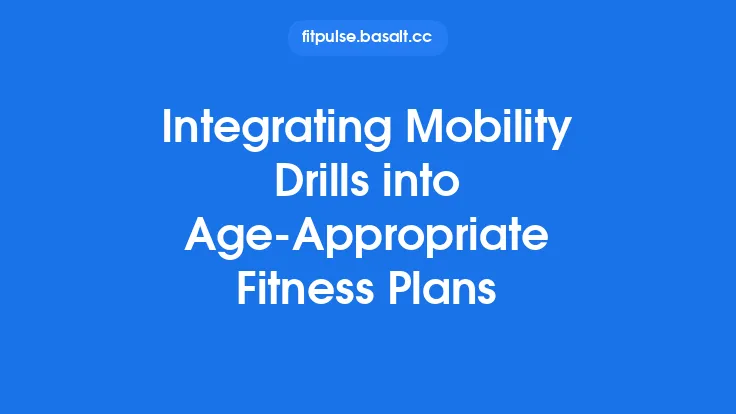Walking and stair climbing are among the most fundamental movements we perform each day. Whether you’re hurrying to catch a bus, navigating a multi‑level home, or simply strolling through a park, the ability to move confidently and efficiently on level ground and up or down stairs is a cornerstone of independent living. While many people assume that walking is “automatic,” it actually relies on a coordinated series of joint motions, muscle activations, and neural patterns. Small deficits in ankle dorsiflexion, hip extension, or knee stability can quickly translate into reduced stride length, altered gait patterns, and an increased risk of trips or falls.
The good news is that targeted mobility drills can restore or enhance the range of motion (ROM) needed for smooth, energy‑efficient walking and stair negotiation. Below is a comprehensive, evergreen guide to simple, equipment‑free drills that you can incorporate into a daily routine. Each exercise is broken down with clear instructions, recommended volume, and cues to help you get the most benefit while staying safe.
Understanding the Mechanics of Walking and Stair Climbing
| Phase | Primary Joint Movements | Key Muscles Involved |
|---|---|---|
| Heel Strike | Ankle dorsiflexion, slight hip extension | Tibialis anterior, gluteus maximus |
| Mid‑Stance | Knee extension, hip extension, ankle plantarflexion | Quadriceps, hamstrings, gastrocnemius |
| Push‑Off | Ankle plantarflexion, hip extension, knee flexion | Gastrocnemius, soleus, gluteus maximus |
| Swing | Hip flexion, knee flexion, ankle dorsiflexion | Iliopsoas, rectus femoris, tibialis anterior |
When climbing stairs, the same joint actions occur but with greater demand on hip and knee extensors during the ascent, and on eccentric control of the quadriceps and ankle dorsiflexors during descent. Mobility limitations in any of these joints can cause compensations such as “toe‑walking,” excessive trunk lean, or reliance on handrails.
Why Mobility Matters for Everyday Walking
- Stride Efficiency – Adequate ankle dorsiflexion allows the foot to land flat, reducing the need for excessive hip flexion and conserving energy.
- Balance Control – Full hip extension and knee flexion range enable smoother weight transfer, which is essential for maintaining the center of mass over the base of support.
- Joint Health – Maintaining ROM prevents abnormal loading patterns that can accelerate cartilage wear or lead to tendinopathies.
- Fall Prevention – Mobility drills improve proprioceptive feedback and muscle activation timing, both critical for reacting to uneven surfaces or missteps.
Identifying Common Mobility Limitations
| Limitation | Typical Signs | Simple Test |
|---|---|---|
| Limited Ankle Dorsiflexion | Heel lifts off ground early, “toe‑walking” | Wall‑ankle test: stand facing a wall, place foot 4‑6 inches away, try to touch the wall with the knee without heel lifting |
| Tight Hip Flexors | Excessive lumbar arch when standing, difficulty achieving full stride | Thomas test: lie on back, pull one knee to chest, observe the opposite thigh’s position |
| Reduced Knee Extension | Inability to fully straighten leg, “locking” sensation | Sit‑to‑stand observation: note if the knee fully extends at the top of the movement |
| Calf Tightness | Limited forward lean, early heel rise | Standing calf stretch: lean forward with one foot back, keep heel on ground; note stretch intensity |
If any of these tests reveal a restriction, prioritize the corresponding drill(s) before moving on to more advanced work.
Core Mobility Drills (Equipment‑Free)
Below each drill includes a brief rationale, step‑by‑step execution, and suggested dosage. Perform the drills 3–4 times per week, ideally after a light warm‑up (e.g., 5 minutes of marching in place).
1. Ankle Dorsiflexion Wall Stretch
Purpose: Increase the range needed for a flat foot strike and proper knee alignment.
- Stand facing a wall, feet hip‑width apart.
- Place the right foot about 4 inches from the wall, toes pointing straight ahead.
- Keep the heel firmly on the ground and gently bend the knee toward the wall.
- When the knee touches the wall, hold for 20–30 seconds; you should feel a stretch in the front of the ankle.
- Repeat 2–3 times per side.
Progression: Add a light backpack (5–10 lb) to increase the stretch intensity.
2. Hip Flexor Mobilization Lunge with Reach
Purpose: Open the hip capsule and lengthen the iliopsoas, facilitating a longer stride.
- Start in a high‑lunge position, right foot forward, left knee on the ground.
- Place both hands on the right thigh for stability.
- Gently press the hips forward while keeping the torso upright; you should feel a stretch in the left hip flexor.
- Hold for 20 seconds, then switch sides.
- Perform 2–3 sets per side.
Tip: Avoid arching the lower back; engage the core to keep the pelvis neutral.
3. Knee Extension Mobilizer (Seated Heel Slides)
Purpose: Promote full knee extension and improve quadriceps activation.
- Sit on a firm chair with feet flat on the floor.
- Slide one heel forward, extending the knee as far as comfortable while keeping the thigh on the seat.
- Hold the extended position for 5 seconds, then return to start.
- Perform 10–12 repetitions per leg, 2 sets.
Progression: Add a light ankle weight (1–2 lb) to increase resistance.
4. Calf Stretch with Dynamic Rock‑Back
Purpose: Lengthen the gastrocnemius and soleus, enhancing ankle plantarflexion during push‑off.
- Stand facing a wall, hands on the wall at shoulder height.
- Step the right foot back, keeping the heel on the ground and the back leg straight.
- Gently rock the hips forward, feeling a stretch in the right calf.
- Hold for 20 seconds, then switch legs.
- Perform 2–3 sets per side.
Dynamic variation: After the static hold, perform 5–6 small “rock‑back” pulses (slight forward‑backward hip movement) to add a neuromuscular component.
Walking‑Specific Mobility Drills
These drills translate the joint ROM gains into functional walking patterns.
5. Heel‑to‑Toe Walk
- Walk forward, placing the heel down first, then rolling through to the toe before lifting the foot.
- Keep the stride length moderate; focus on a smooth transition.
- Perform 10 meters, turn around, and repeat 2–3 times.
Benefit: Reinforces proper ankle mechanics and encourages a full foot roll‑through.
6. High‑Knee March with Arm Drive
- Stand tall, engage the core.
- March in place, lifting each knee to at least hip height while swinging the opposite arm forward.
- Perform for 30 seconds, rest 15 seconds; repeat 3 rounds.
Why it works: Increases hip flexion ROM and improves coordination between upper and lower body, mimicking the swing phase of gait.
7. Lateral Step‑Walk (Side Shuffle)
- Place a line or tape on the floor about 12 inches apart.
- Step laterally over the line with the right foot, then bring the left foot to meet it; repeat in the opposite direction.
- Perform 10 steps each way, 2 sets.
Focus: Enhances hip abductor and adductor mobility, which contributes to lateral stability during walking on uneven terrain.
Stair‑Specific Mobility Drills
Stair climbing demands greater eccentric control and joint range. The following drills can be done on a single step or a low platform (6–8 inches high) if a full staircase isn’t available.
8. Step‑Up with Controlled Descent
- Stand facing a step; place the right foot fully on the step.
- Push through the heel to lift the body, bringing the left foot up to meet the right.
- Slowly lower the left foot back to the ground, then the right foot, maintaining control.
- Perform 10 repetitions per leg, 2 sets.
Key cue: Keep the knee aligned over the foot; avoid letting it collapse inward.
9. Lateral Step‑Down (Side‑Step)
- Stand sideways to the step, right foot on the step, left foot on the floor.
- Lower the right foot laterally off the step, allowing the knee to bend slightly as you touch the floor.
- Return to the starting position by stepping back onto the step.
- Perform 10 repetitions per side, 2 sets.
Purpose: Improves hip abductor strength and ankle stability needed for safe stair descent.
10. Stair March (Alternating Step‑Up)
- Using a low step, place the right foot on the step, then bring the left knee up toward the chest (as if marching).
- Return the left foot to the floor, then repeat on the opposite side.
- Continue alternating for 30 seconds, rest 15 seconds; repeat 3 rounds.
Benefit: Encourages hip flexion and knee lift while maintaining balance on a raised surface.
11. Controlled Stair Descent with “Heel‑to‑Toe” Emphasis
- Stand on the top step, both feet fully on the step.
- Lower one foot to the next lower step, placing the heel down first, then rolling to the toe.
- Follow with the other foot, maintaining a smooth, controlled motion.
- Perform 5–6 stair levels (or repeat on a single step if limited), focusing on ankle dorsiflexion and knee control.
Safety tip: Keep a hand lightly on a railing if needed, but aim to bear most of the load through the legs.
Progression Strategies
| Stage | Criteria | Next Step |
|---|---|---|
| Foundation | Able to complete all drills with proper form, no pain, and a comfortable ROM | Increase repetitions (e.g., from 10 to 15 per set) |
| Strength Integration | Demonstrates control during eccentric phases (e.g., stair descent) | Add light resistance (ankle weights, resistance bands) |
| Functional Transfer | Performs drills fluidly in a real‑world environment (e.g., walking on uneven pavement) | Incorporate interval walking or stair circuits (e.g., 2 min walk, 1 min stair climb) |
| Advanced Mobility | Seeks further ROM gains for sport or high‑intensity activity | Introduce dynamic mobility combos (e.g., walking lunges with torso rotation) |
Progression should be gradual; a 10% increase in volume or load per week is a safe guideline.
Safety Considerations & Common Mistakes
- Rushing the Stretch – Holding a stretch for less than 15 seconds reduces its effectiveness. Use a timer if needed.
- Compensatory Trunk Lean – When ankle dorsiflexion is limited, many people lean forward excessively. Focus on keeping the torso upright; if needed, reduce the step height until mobility improves.
- Knee Valgus During Step‑Ups – Allowing the knee to collapse inward stresses the medial knee structures. Cue “knees over toes” and engage the glutes.
- Heel Lifting on Flat Ground – If the heel lifts during heel‑to‑toe walking, it often signals tight calves. Return to the calf stretch before proceeding.
- Over‑reliance on Handrails – While handrails are useful for safety, excessive reliance can mask balance deficits. Practice short, unsupported descents once confidence builds.
Monitoring Progress
- Range of Motion Measurements: Re‑test the wall‑ankle test and hip‑flexor stretch every 4–6 weeks. An improvement of 2–3 cm in foot‑to‑wall distance or a 5‑degree increase in hip extension is a meaningful gain.
- Gait Observation: Record a short video of a normal walk and a stair climb. Look for smoother foot placement, reduced trunk sway, and a more symmetrical stride.
- Functional Benchmarks: Use the “Timed Up‑and‑Go” (TUG) test or a 10‑meter walk test to quantify speed improvements. A reduction of 1–2 seconds in TUG often reflects better mobility.
Frequently Asked Questions
Q: How long will it take to notice improvements?
A: Most individuals report a perceptible increase in stride length and stair confidence within 2–3 weeks of consistent practice (3–4 sessions per week). Full ROM gains may take 6–8 weeks, depending on baseline flexibility.
Q: Can I do these drills if I have mild osteoarthritis in the knee?
A: Yes, provided the movements are pain‑free. Emphasize controlled, low‑impact versions (e.g., use a low step, avoid deep knee bends) and consult a healthcare professional if pain persists.
Q: Do I need any equipment?
A: No. All drills can be performed with body weight. Optional light ankle weights or a resistance band can be added once the basic patterns are mastered.
Q: How do I integrate these drills into a busy schedule?
A: A 10‑minute “mobility burst” in the morning (static stretches) followed by a 5‑minute walking drill after lunch, and a quick stair circuit in the evening works well for most people.
Bringing It All Together
Walking and stair climbing are daily actions that rely on a harmonious blend of joint mobility, muscle activation, and neural coordination. By systematically addressing the most common mobility bottlenecks—ankle dorsiflexion, hip flexor length, knee extension, and calf flexibility—you lay the groundwork for a smoother, safer gait. The drills outlined above are intentionally simple, requiring no special equipment, yet they target the precise ranges of motion needed for efficient level‑ground walking and confident stair navigation.
Consistency is the key driver of lasting change. Start with the foundational static stretches, progress to dynamic walking drills, and then challenge yourself with stair‑specific movements. Monitor your range, watch for improvements in stride quality, and adjust the difficulty as you advance. Over time, you’ll notice not only a more comfortable walk and easier stair climbs but also a boost in overall confidence and independence in daily life.
Keep moving, stay mindful of your form, and let these mobility drills become a natural part of your day‑to‑day routine. Your feet, knees, and hips will thank you.





